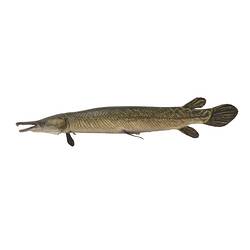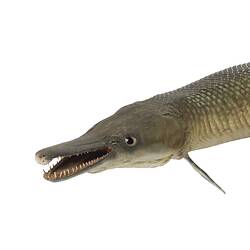Summary
Alligator Gar are a freshwater fish found in slow-moving or still freshwater bodies across the south of North America. They can reach over 2 m in length and weigh 45 kg making them the largest species of gar and one of the largest species of freshwater fish in North America. They are often called living fossils because of their primitive anatomical features. They are ambush predators, "hunting" by staying still waiting for a prey item, including aquatic birds and small mammals, to approach.
This specimen came from Texas. It was donated to the Museum in 1890 by Henry Ward (1834-1906), the American naturalist and natural history dealer.
Alligator Gar are fished and bow-fished by individuals and commercially. Overfishing is a problem for this species and this, in addition to the destruction of their habitat, particularly around the mouths of rivers, has led to a reduction in their range and they are now considered rare or Endangered in some areas.
Specimen Details
-
Taxon Name
-
Author and date of publication
Lacepède, 1803
-
Preferred Common name
Alligator Gar
-
Date Identified
1999
-
Identified By
Tania M. Bardsley - Museum Victoria
-
Number Of Specimens
1
-
Sex
Unknown
-
Specimen Nature
Form: Dry
-
Category
-
Scientific Group
-
Discipline
-
Collecting Areas
-
Type of Item
Taxonomy
-
Kingdom
-
Phylum
-
Subphylum
-
Superclass
-
Class
-
Order
-
Family
-
Genus
-
Species Name
spatula
Geospatial Information
-
Country
-
Precise Location
Texas







![<em>Lepisosteus spatula</em>, Alligator Gar. [54809]](/content/media/3/1068453-thumbnail.jpg)
